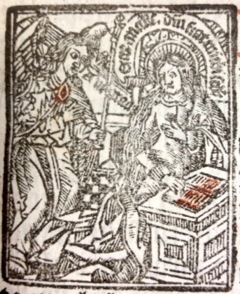Colour-Printed Book Illustrations in Tudor England, 1485-1603
October 10th, 2012Gallery; Jason Scott-WarrenElizabeth Upper, Munby Fellow in Bibliography at Cambridge University Library 2012-13
The study of the history of English colour prints is grounded on the belief that none were produced for the 250 years between the Book of St. Albans in 1486 and the explosion of publications with colour illustrations in the mid-eighteenth century. However, many Tudor woodcuts printed in colour survive; all are book illustrations that have not been systematically described as colour prints by bibliographers and are not known to art historians, and many have innovative techniques or use colour in surprising ways. These vivid borders, vignettes, printers’ devices and zodiacal men challenge long-held assumptions about the relationship between printed text and image in early English publications and the early history of colour printing in Europe.
This surprising gap in the literature has not been challenged by historians of art, literature, printing or the book; studies of English colour prints that encompass the sixteenth and seventeenth centuries either skip from the one book in 1486 to the mid-1700s or simply start with the latter. They are inconsistently recorded in histories of colour printing and bibliographical studies of early English books. The oversight is not local; there is a similar neglect of colour-printed illustrations from sixteenth-century books in countries as far-flung as France, Mexico, Portugal, Spain and Switzerland due to the lack of a standard descriptive terminology for their unusual techniques of printing, a pervasive bias against colour in the study of graphic art, and the absence of colour from many digitization projects.
Addressing these omissions, my project for the 2012/2013 Munby Fellowship in Bibliography at the Cambridge University Library will result in the first study of sixteenth-century English colour prints. It will demonstrate that not only were colour prints produced in Tudor England, but also that their numbers and techniques are in keeping with previously unrecognized European trends uncovered by my dissertation research.

The Annunciation, colour woodcut from two impressions (black and red), in The Primer in Latin and Englishe [1555]. CUL, Young 263, fol. A1r. With the permission of the Syndics of the Cambridge University Library.
The anticipated findings about early, vivid and visual paratexts and the widespread dissemination of colour printing techniques in the sixteenth century should be relevant to fields including bibliography, the history of the book, the history of art and the study of material texts. As this project demonstrates that Tudor colour woodcuts are important expressions of international trends in the first centuries of colour printing, its immediate impact should be the enabling of further bibliographical research about early English colour printing, especially in Cambridge collections. In the longer term, it should contribute to the reassessment of the role and reception of colour in printmaking in early modern Europe.